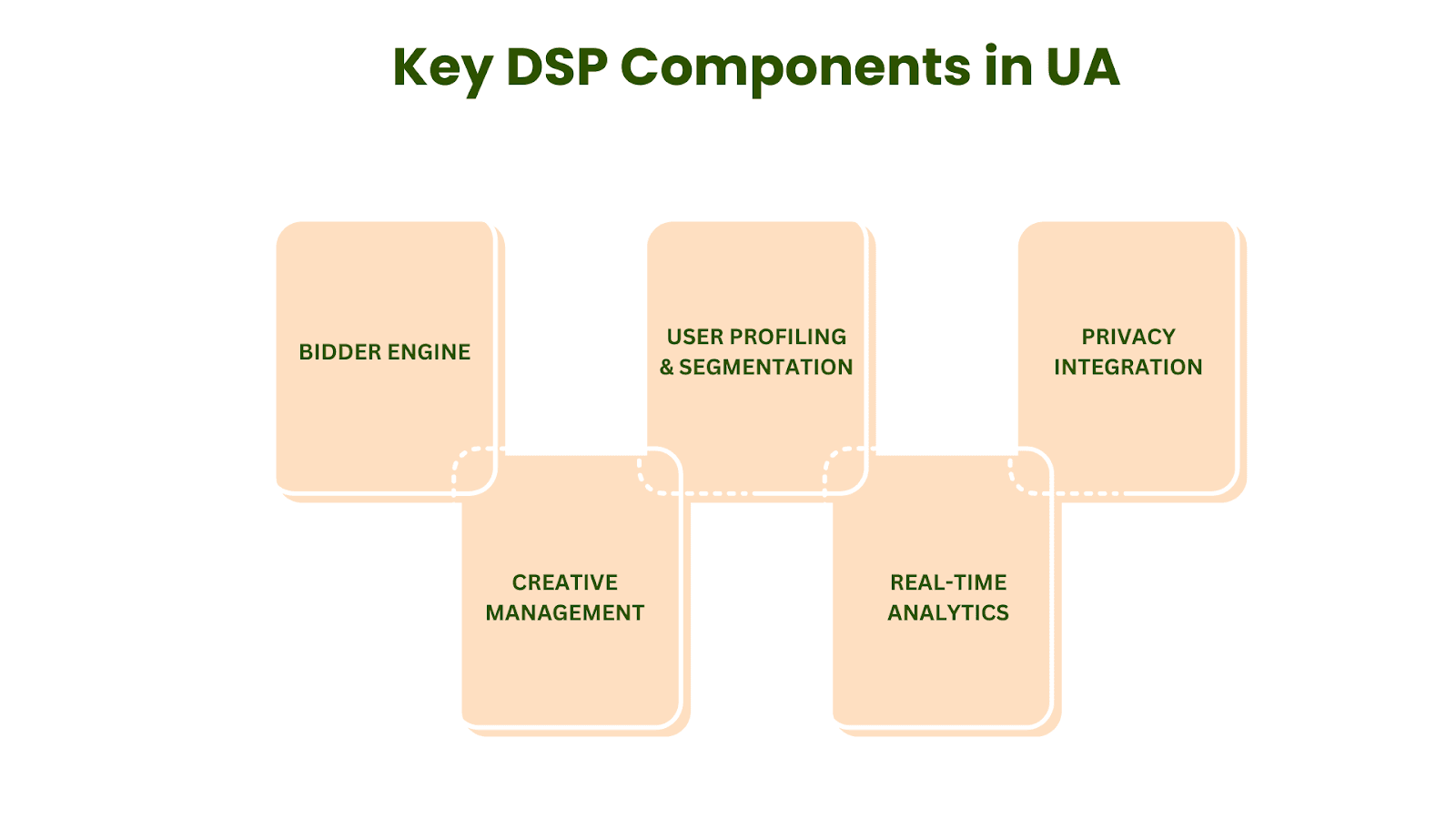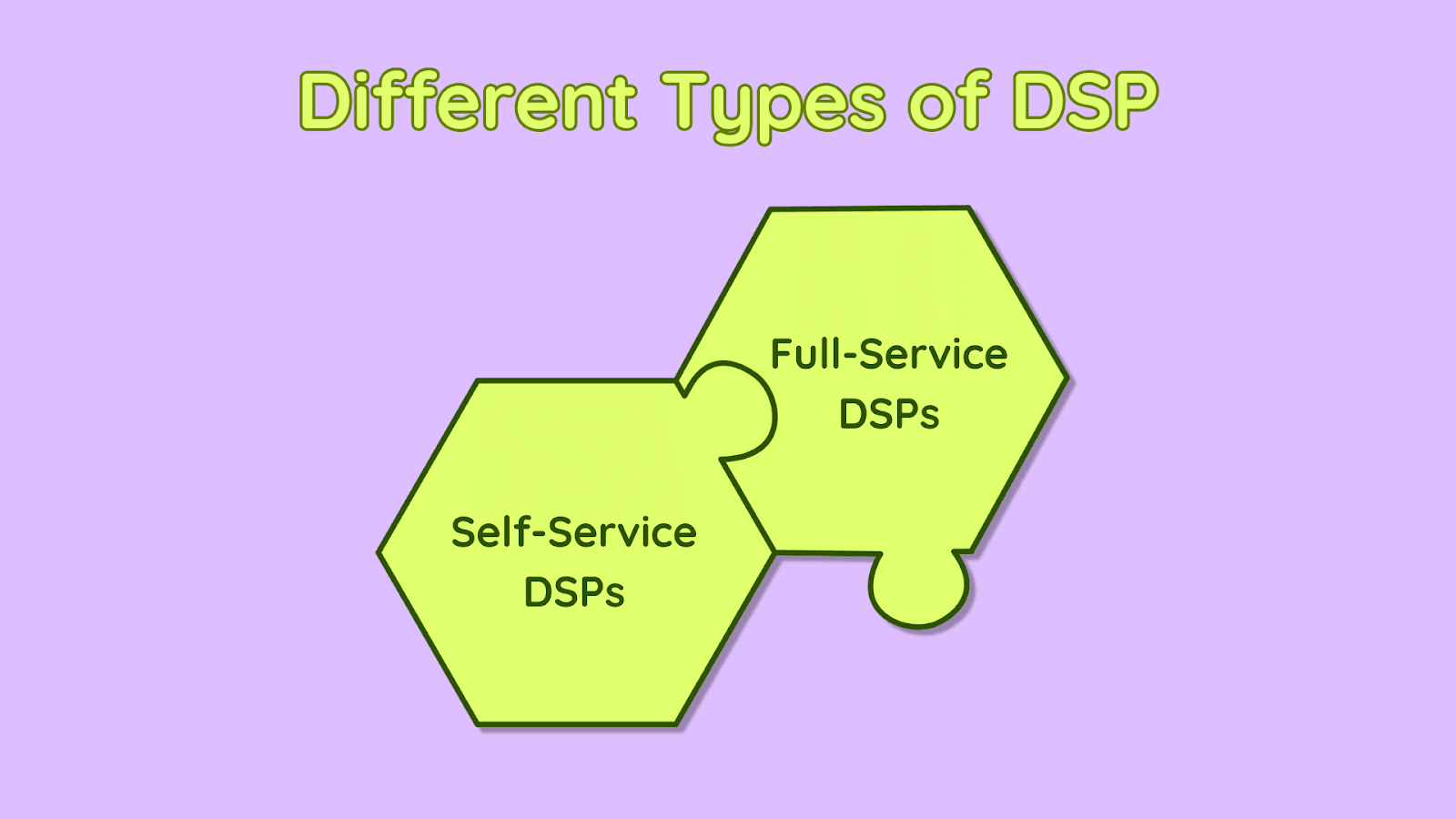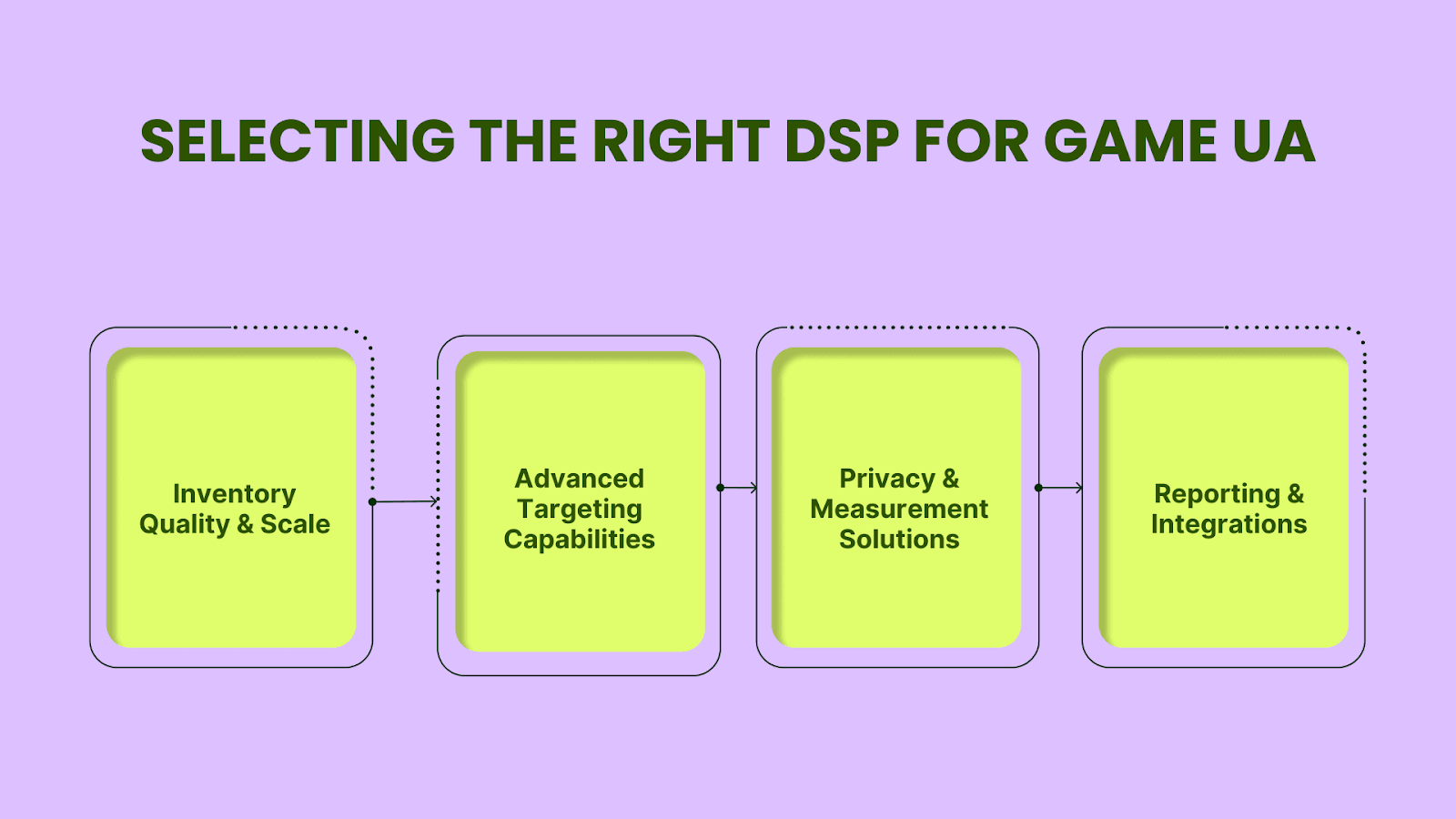What is a Demand-Side Platform (DSP)? A Complete Guide
You’re burning budget across dozens of ad networks, tweaking bids by hand, and still missing the players who really matter. You need a way to stop guessing and start winning installs at scale. That’s where a Demand-Side Platform (DSP) steps in as a centralized, automated hub for real-time bidding and data-driven optimization, ensuring you reach high-value users and scale installs effectively.
A DSP transforms your UA chaos into clear, cost-efficient growth by centralizing every auction, targeting signal, and creative test into one platform. You’ll eliminate wasted spend on low‑value impressions, reach high‑intent players across regions in real time, and free your team to focus on strategy instead of spreadsheets.
In this blog, you’ll first get a clear definition of “what is a DSP” and why it’s critical for scalable UA, then walk through the core components and campaign workflow that power programmatic bidding. Next, we’ll compare self‑service versus full‑service DSP models and outline how to choose the right platform for your mobile game. Finally, you’ll discover best targeting, bidding, and privacy‑compliant optimization practices to maximize installs and ROI.
What is a Demand-Side Platform (DSP)?
A demand-side platform (DSP) is a software platform that enables advertisers and agencies to automatically bid on and purchase digital ad inventory across multiple ad exchanges, SSPs, and real-time bidding networks, including formats such as display, video, mobile, audio, and connected TV, through a single interface.
It uses algorithms to place bids on individual impressions that match predefined UA criteria such as cost-per-install (CPI) goals, user location, operating system, and device model. Instead of negotiating directly with each publisher, you set campaign rules and let the DSP handle auctions programmatically.
Why DSPs Matter for Mobile Game UA?
To understand the impact of demand-side platforms on mobile game user acquisition (UA), consider how their real-time automation and data-driven insights enhance campaign performance. Here's how DSPs contribute to reach, precision, and cost efficiency:
Scale & Reach: DSPs connect to hundreds of ad exchanges and SSPs, delivering diverse ad formats like banners, rewarded videos, and playables across thousands of apps and sites. Campaigns can launch globally at once, accessing markets in North America, Europe, Asia, and emerging regions without extra setup.
Precision Targeting: DSPs use granular segments based on in-app behavior, demographics, and context to find engaged players. Device and OS filters help exclude low-performing models or target premium devices for better efficiency. DSPs today balance precision with privacy. With IDFA restrictions and Android’s Privacy Sandbox, many DSPs now rely on probabilistic and contextual signals rather than deterministic user IDs.
Cost Control: Automated bid management adjusts bids in real time to meet CPI targets. Dynamic floor pricing updates minimum bids automatically to avoid overspending on low-value impressions and maximize ROI.
By integrating a DSP into a mobile game UA stack, teams gain centralized control over campaign settings, tap into extensive inventory, and maintain tight cost oversight, all critical for scaling user acquisition efficiently.
Understanding the impact of DSPs on scale, targeting, and cost efficiency sets the stage for a closer look at the core building components that power these platforms.
Also Read: How to Optimize UA Budget Allocation In Mobile Advertising in 2025
Key DSP Components in UA
Successful UA for mobile games hinges on a centralized DSP that consolidates real-time bidding, creative testing, audience modeling, analytics, and privacy-first attribution in one dashboard:

1. Bidder Engine
The bidder engine powers real-time bidding (RTB) auctions, using historical performance data and machine-learning models to predict the optimal bid for each impression in milliseconds. This ensures you win high-value placements at the lowest possible cost per install (CPI).
By continuously training on past campaigns, the engine adjusts bid curves dynamically, shifting spend toward user segments and geographies that drive the best lifetime value (LTV) while avoiding overspending on low-quality traffic.
2. Creative Management
A robust creative management module supports all leading mobile-game ad formats, playable ads for hands-on demos, rewarded video for opt-in engagement, and interstitials for broad reach. It streamlines A/B testing of thumbnails, calls-to-action, and video variants so UA managers can identify the best-performing assets without manual workflows.
Integrated asset versioning and performance tracking let teams roll out new creative themes in one click and automatically reallocate budget to top performers, reducing time to insight and improving overall click-through rates (CTR) and install rates.
3. User Profiling & Segmentation
This component ingests first-party data from your CDP (Customer Data Platform) and mobile measurement partner (MMP) to build unified user profiles. It then applies lookalike modeling to find new gamers who mirror your best customers, and sets up retargeting pools to re-engage lapsed players. Due to evolving privacy frameworks, DSPs increasingly rely on modeled audiences and contextual insights instead of persistent user-level identifiers.
Segments can be based on in-game behavior, geolocation, device type, or ad engagement, enabling precise audience selection for high ROI campaigns and lowering wasted ad spend.
4. Real-Time Analytics
Custom dashboards display key UA metrics, CPI, installs, LTV curves, and Day-1/7/30 retention, updated continuously in real time. These insights allow UA managers to pause underperforming channels, shift budget to rising regions, or swap in new creatives without delay.
Built-in anomaly detection flags unexpected drops in install volume or spikes in CPI, helping teams react before costs spiral and ensuring campaign KPIs stay on track.
5. Privacy Integration
The platform natively supports SKAdNetwork 4.0 to maintain attribution under Apple’s IDFA restrictions. It handles campaign registration, crowd-anonymity thresholds, conversion value mapping, and multi-window postbacks so you don’t lose visibility on iOS installs.
Contextual targeting modules complement SKAN by using non-personal signals (app category, device model, region) to find high-intent users without relying on identifiers.
Each DSP component works together to give UA teams the tools they need to scale user acquisition efficiently and compliantly in 2024–2025. With the essential modules of a DSP, from bidding engines to privacy integrations, let’s explore how different service models package those capabilities for your UA team.
Different Types of DSP
Advertisers can choose between self-service and full-service DSP models, depending on how much in-house control versus external support they need for efficient user acquisition.

1. Self-Service DSPs
Self-service DSPs are platforms where advertisers run their campaigns end-to-end, from uploading creatives to setting bids and targeting criteria. These tools empower you to adjust bids in real time, optimize audience segments, and manage budgets directly, which helps maintain tight control over cost-per-install (CPI) and overall spend.
Since self-service DSPs typically operate on subscription or pay-as-you-go models, they often offer lower entry costs and higher transparency into spend and performance, aiming to maximize ROI.
From a UA perspective, self-service DSPs support rapid experimentation. You can immediately test new audiences or creatives and iterate based on real-time analytics, an approach that becomes critical under evolving privacy constraints and shifting platform policies.
2. Full-Service DSPs
Full-service DSPs provide managed solutions where an agency or platform team handles campaign setup, optimization, and reporting on behalf of the advertiser.
Advertisers who choose full-service gain access to dedicated account managers and strategic experts, who can accelerate time to market and ensure campaigns follow best practices without requiring deep in-house DSP expertise.
Full-service DSPs offer a turnkey option for those focused on creative development or broader marketing strategy. Specialists use advanced algorithms and industry benchmarks to handle performance goals such as cost-per-acquisition (CPA), retention rates, and lifetime value (LTV) optimization. They may also offer proprietary machine-learning models to optimize spend across creatives and geos, especially valuable in markets where user behavior varies by region.
This model can be particularly valuable for apps scaling into new markets or channels where localized expertise drives better user acquisition outcomes.
Aligning DSP choice with your UA team’s desired mix of hands-on control or expert-led execution ensures every campaign is built to meet precise acquisition targets.
Whether you choose a self-service or a full-service DSP, the underlying mechanics remain grounded in programmatic auctions, so let’s see exactly how that process works.
How DSPs Work in Mobile Gaming UA
Programmatic DSPs automate media buying across multiple exchanges in milliseconds, unifying targeting, bidding, and reporting. DSPs receive impression requests from publishers' SSPs through real-time auctions, enabling precise optimization by geography, device, and creativity to meet CPI and ROAS goals.
1. Campaign Setup:
Before any auction, you define campaign parameters in the DSP dashboard: CPI target, geo-targets (e.g., US, DE, BR), device OS and models, plus creative formats like playables or video. These inputs align spend with business goals, whether volume installs or profitable ROAS, so the DSP’s bidding engine knows which impressions meet campaign criteria.
2. RTB Auction:
When a user opens a publisher’s app (e.g., Royal Match, Gardenscapes), the SSP sends an OpenRTB bid request containing impression metadata, user context, and floor price to connected DSPs. The DSP evaluates each request, matching against predefined targeting, predicting click and conversion rates, then computing an optimal bid, and submits its offer within ~50 ms. Most exchanges now run on first-price auctions, meaning bid accuracy and floor strategies are more important than ever. If the bid clears the auction, the DSP wins the impression and secures the ad slot.
3. Ad Delivery:
Upon winning, the DSP returns the ad markup (e.g., HTML5 playable) or directs an SDK to render the creative, and the ad appears instantly in the user’s app session. Install events and downstream in-app metrics are attributed back via the integrated mobile measurement partner or Apple’s SKAdNetwork postbacks, ensuring privacy-compliant, aggregated performance data.
4. Optimization Loop:
Live performance metrics, CPI, click-through rates, and post-install conversion values feed into the DSP’s optimization engine, which applies preset rules or ML models to adjust bids and budget allocation across geos, devices, and creatives. Over time, spending shifts toward segments and ad formats delivering the best ROI, continuously improving campaign efficiency and scale. Some DSPs apply reinforcement learning or Bayesian updates to their bid strategies for improved real-time budget reallocation.
This end-to-end process turns raw auction data and live performance signals into smarter spend decisions, so every impression moves you closer to your next wave of high-value players.
Having walked through the end-to-end flow of programmatic bidding and optimization, you can now evaluate which DSP best aligns with your game’s unique UA goals.
Selecting the Right DSP for Game UA
Choosing the right Demand-Side Platform (DSP) for game user acquisition (UA) means finding a partner that offers broad, high‐quality inventory, precise audience targeting, strong privacy and measurement tools, and smooth data flows into your analytics stack.

1. Inventory Quality & Scale
Selecting a DSP begins with evaluating its reach and the quality of its ad inventory. Look for DSPs that:
Supply from gaming-focused exchanges: DSPs connected to exchanges dedicated to games (rather than general display) deliver placements alongside relevant titles and formats, boosting engagement rates.
Direct app-store integrations: Partnerships with app marketplaces (for example, Google Play-oriented SDKs) let you tap first-party inventory and benefit from store-specific ad units optimized for installs.
Global scale with fraud protection: A broad footprint across regions, plus built-in traffic filtering, ensures you hit volume targets without wasting spend on invalid clicks or bots.
2. Advanced Targeting Capabilities
Reaching lookalike gamers and lapsed players drives both scale and efficiency. Evaluate whether a DSP offers:
Lookalike modeling based on your highest‐value cohorts to expand reach to similar users.
Contextual signals include app category, device model, and session time to serve ads where gamers are most likely to convert.
Retargeting workflows that let you re‐engage existing players with in-game rewards or new content announcements, maximizing ROI from your install base.
3. Privacy & Measurement Solutions
With iOS privacy rules and Google’s changes, accurate attribution is key. Confirm that the DSP:
Supports Apple SKAdNetwork natively, handling postback validation and conversion value mapping without additional development.
Partners seamlessly with top MMPs (e.g., AppsFlyer, Adjust, Branch), so install and engagement data flow directly into your trusted attribution platform.
4. Reporting & Integrations
To optimize cohorts and lifetime value (LTV), you need detailed data:
Real-time export to BI: Look for DSPs offering API or data-warehouse connectors so you can pull daily install data, cost metrics, and early LTV signals into your analytics tools.
Cohort analysis support: Ensure the platform can segment installs by campaign or audience, then feed short-term engagement metrics (D1, D7 retention) back into your MMP or BI dashboard. Advanced DSPs also support incrementality testing, allowing UA managers to measure lift in conversions across creatives or geos.
Unified cost and revenue views: Integration with your MMP should allow you to see cost per install alongside early‐stage revenue, giving you a clear view of short-term LTV without manual stitching.
By prioritizing these four areas, inventory, targeting, measurement, and reporting, you’ll pick a DSP that drives installs and fuels data-driven growth for your game.
Top 3 DSPs in Mobile Gaming 2025
DSP | Key Strength | Pricing Model |
Unity Ads | Rewarded, interstitial & banner SDK | Auction-based CPM/CPI |
AppLovin (MAX) | Mediation + real-time A/B testing | First-price CPM with auto-floors |
ironSource LevelPlay | All formats + offerwall in one SDK | Hybrid CPM/CPI bidding |
Note: While platforms like Unity Ads and AppLovin primarily offer mediation and SDK-based inventory, they also offer DSP-like programmatic bidding through tools such as Unity Audience Pinpointer and AppLovin AXON.
Once you’ve chosen a platform that checks all your boxes, the next step is implementing proven strategies that maximize performance, so let’s cover some UA best practices.
Best Practices
Set up your UA framework with clear phases for targeting, bidding, and attribution:
Begin with targeted geo and device segments, then scale winners by increasing budgets on top performers. Launch initial tests in specific regions or OS/device types to isolate high-value audiences; once a segment shows strong CPI and retention, reallocate more spend to it.
Test floor price vs. auto-bid algorithms to find the optimal CPI balance. Compare campaigns using manual, static bid floors (reserve prices) against those leveraging your DSP’s real-time bidding algorithms to see which yields lower CPIs without sacrificing volume. Playables launched in early 2025 show strong performance variance across regions, so test regional variants of the same creative to optimize CPI.
Sync SKAN conversion windows to pacing, align campaign spend pacing with your configured SKAdNetwork postback windows (e.g., days 1–2, 3–7, 8–35). Set daily or weekly spend caps corresponding to SKAN’s three postback intervals to capture timely conversion data and avoid attribution gaps.
These steps will help you run efficient, data-driven UA campaigns on iOS with clear insights at each stage.
Also Read: Analyzing And Measuring Campaign Performance Metrics And Strategies
Conclusion
Demand-side platforms (DSPs) have become indispensable for mobile game user acquisition by centralizing real-time bidding, creative testing, audience segmentation, and privacy-compliant attribution into one powerful interface.
By tapping into vast ad inventories across display, video, and mobile, DSPs let your UA teams scale campaigns globally with precision targeting, filtering by device, OS, geography, and user behavior, to maximize installs while controlling cost-per-install (CPI). Automated bid management and dynamic floor pricing ensure budgets flow to the highest-value impressions, while integrated analytics and anomaly detection keep campaign KPIs on track.
Whether you choose a self-service DSP for hands-on experimentation or a full-service model for expert-led execution, the right platform streamlines creative workflows, enables rapid A/B testing, and unifies cost and revenue data for data-driven optimization.
Ready to see how Segwise AI can supercharge your next campaign? Start your 14-day free trial today, and let our AI Agents work on your user acquisition goals.
FAQs
1. What advantage does a DSP offer over managing bids manually?
A DSP automates bidding across multiple ad exchanges, using real-time data and machine learning to hit your cost-per-install targets and cut wasted spend on low-value impressions.
2. How does a DSP’s real-time bidding process function?
When an ad opportunity arises, the DSP evaluates request details (e.g., user region, device, historical performance), computes an optimal bid in milliseconds, and enters the auction programmatically.
3. What are the main differences between self-service and full-service DSPs?
With self-service, you handle everything directly in the platform, from creative uploads to bid rules. Full-service bundles campaign setup, optimization, and reporting via a dedicated team or agency.
4. Which core modules should I expect in a mature DSP?
Look for a bidder engine, creative manager, audience segmentation, live analytics dashboard, and built-in privacy/ad-attribution integration (e.g., SKAdNetwork support).
5. How do DSPs maintain compliance under modern privacy frameworks?
They natively integrate solutions like SKAdNetwork 4.0 for iOS attribution, use aggregated/contextual signals instead of personal identifiers, and work with top measurement partners to preserve data accuracy.
Comments
Your comment has been submitted successfully!